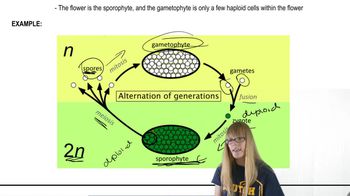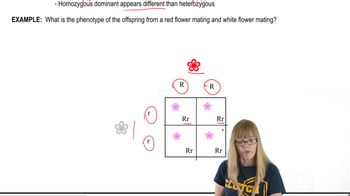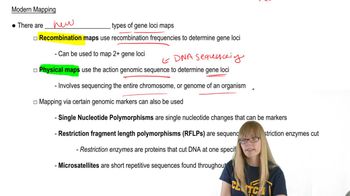Table of contents
- 1. Introduction to Genetics51m
- 2. Mendel's Laws of Inheritance3h 37m
- 3. Extensions to Mendelian Inheritance2h 41m
- 4. Genetic Mapping and Linkage2h 28m
- 5. Genetics of Bacteria and Viruses1h 21m
- 6. Chromosomal Variation1h 48m
- 7. DNA and Chromosome Structure56m
- 8. DNA Replication1h 10m
- 9. Mitosis and Meiosis1h 34m
- 10. Transcription1h 0m
- 11. Translation58m
- 12. Gene Regulation in Prokaryotes1h 19m
- 13. Gene Regulation in Eukaryotes44m
- 14. Genetic Control of Development44m
- 15. Genomes and Genomics1h 50m
- 16. Transposable Elements47m
- 17. Mutation, Repair, and Recombination1h 6m
- 18. Molecular Genetic Tools19m
- 19. Cancer Genetics29m
- 20. Quantitative Genetics1h 26m
- 21. Population Genetics50m
- 22. Evolutionary Genetics29m
4. Genetic Mapping and Linkage
Mapping Genes
Problem 29c
Textbook Question
A 2006 genetic study of a large American family (Ikeda et al., 2006) identified genetic linkage between DNA markers on chromosome 11 and the gene producing the autosomal dominant neuromuscular disorder spinocerebellar ataxia type 5 (SCA5). The following lod score data are taken from the 2006 study: Theta (θ) Value 0.01 0.05 0.10 0.20 0.30 0.40SCA5 11.02 12.26 11.94 10.04 7.26 3.77 and DNA marker A SCA5 0.35. 0.94. 1.07 0.99 0.75 0.43 and DNA marker B Does either group of lod scores indicate statistically significant odds in favor of genetic linkage? Explain your answer.
 Verified step by step guidance
Verified step by step guidance1
Understand that a LOD (logarithm of the odds) score is used to determine the likelihood of genetic linkage between a marker and a trait. A LOD score of 3 or higher is generally considered evidence of linkage.
Examine the LOD scores for DNA marker A: 11.02, 12.26, 11.94, 10.04, 7.26, and 3.77. All these scores are above 3, indicating strong evidence of linkage.
Examine the LOD scores for DNA marker B: 0.35, 0.94, 1.07, 0.99, 0.75, and 0.43. All these scores are below 3, indicating no significant evidence of linkage.
Compare the LOD scores for both markers. Marker A consistently shows scores above 3, while Marker B does not reach the threshold of 3 in any instance.
Conclude that the LOD scores for DNA marker A indicate statistically significant odds in favor of genetic linkage, whereas the scores for DNA marker B do not.
Recommended similar problem, with video answer:
 Verified Solution
Verified SolutionThis video solution was recommended by our tutors as helpful for the problem above
Video duration:
2mPlay a video:
Was this helpful?
Key Concepts
Here are the essential concepts you must grasp in order to answer the question correctly.
Lod Score
A lod score (logarithm of the odds) is a statistical measure used to evaluate the likelihood of genetic linkage between a trait and a specific genetic marker. A lod score greater than 3 is typically considered evidence of significant linkage, while a score less than -2 suggests no linkage. In the context of the study, analyzing the lod scores for different theta values helps determine if the observed genetic markers are associated with the SCA5 disorder.
Recommended video:
Guided course

Formation of Plant Gametes
Theta (θ) Value
Theta (θ) represents the recombination fraction, which is the probability that a crossover will occur between two loci during meiosis. It ranges from 0 to 0.5, where 0 indicates complete linkage (no recombination) and 0.5 indicates independent assortment. In the context of the lod score analysis, different theta values are used to assess the strength of the genetic linkage between the markers and the SCA5 gene.
Recommended video:
Guided course

Step 3
Autosomal Dominant Inheritance
Autosomal dominant inheritance is a pattern where only one copy of a mutated gene from an affected parent can cause the disorder in offspring. This means that the trait can be passed down through generations, with each child having a 50% chance of inheriting the condition. Understanding this inheritance pattern is crucial for interpreting the genetic linkage findings in the study, as it informs the expected distribution of the disorder within the family.
Recommended video:
Guided course

Variations on Dominance
Related Videos
Related Practice





